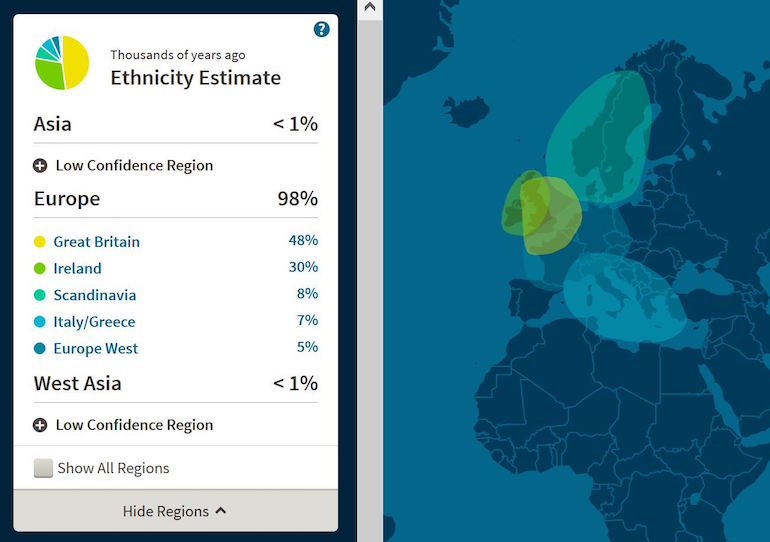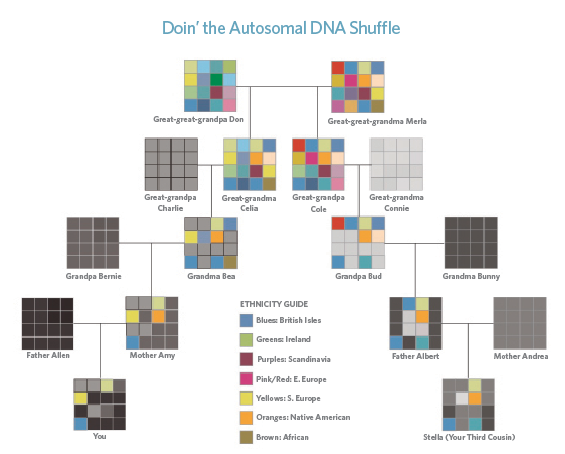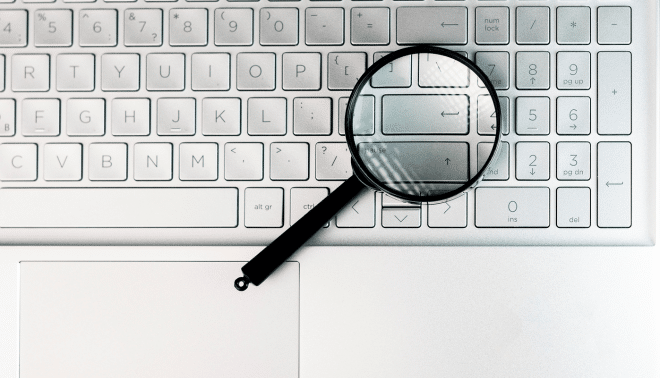Sign up for the Family Tree Newsletter! Plus, you’ll receive our 10 Essential Genealogy Research Forms PDF as a special thank you.
Get Your Free Genealogy Forms
"*" indicates required fields

Jump to:
Q: How do maps from different DNA testing companies compare?
Q: Can a DNA map verify a family legend of American Indian ancestry?
Q: Why do I see locations in my map that don’t match my research? Why don’t I see locations that I’ve found through research?
Q: Do I need to be an archeologist or a population geneticist to understand these ethnicity maps?
Q: Can you explain the science behind these maps?
Q: How do maps from different DNA testing companies compare?
A: Four major companies offer autosomal DNA testing for genealogy: 23andMe, Family Tree DNA, Ancestry.com and MyHeritage DNA. A fifth, the Genographic Project, is interested mostly in ancient human history and migrations, not in helping you find ancestors.
The way each testing company has divided up the world into populations is different. For example, 23andMe groups British and Irish, Ancestry DNA separates these two, and Family Tree DNA includes them in Western and Central Europe. For each testing company, the reference populations your genetic data are compared against are a major factor that determines what your ethnicity map looks like.
Each testing company has a unique mix of reference population samples. Because the three companies compare your DNA samples to different pools of data, it’s no surprise that their results don’t line up exactly.
In addition, the reference populations are weighted quite a bit toward European groups. So if you have African, Asian or Middle Eastern origins, the testing won’t be as fruitful because the comparison pool is so small.
Inevitably, the next question is either “Which company does the best job at determining my admixture results?” or “Which company is best for identifying Native American (or Jewish, or African) ancestry?” The short answer is, in the words of genetic genealogist Judy Russell, who blogs at The Legal Genealogist “Test at all three and your results are probably somewhere in the middle.” I couldn’t agree more.

Q: Can a DNA map verify a family legend of American Indian ancestry?
A: The answer is a resounding “yes!” Followed by an equally emphatic “sometimes.”
The ancestor you suspect is the source of your American Indian heritage should be within the last five generations. The further back your American Indian ancestor, the smaller the portion of DNA you share with him or her. Beyond five generations, chances are you won’t have inherited enough of any one ancestor’s DNA to be confident a test will detect it.
For the same reason, a DNA test can’t negate the possibility of a specific ethnic heritage: If Native American designations show up on your test, you have an American Indian ancestor—but the absence of Native American DNA in your results doesn’t mean that you don’t have an Indian ancestor. If your third-great-grandmother was Indian, for example, it’s possible you just didn’t inherit any of her American Indian DNA.
For most people, ethnicity estimates’ best genealogical benefit is to give you confidence you’re going down the right path and encourage you to keep searching for documentation of a specific ethnic heritage.

Say each of your relatives’ autosomal DNA was a big square, made up of smaller colored squares of DNA associated with various ethnic groups. Here, American Indian DNA is orange. Notice that you (there at the bottom left) have no orange in your DNA. Does that mean your great-great-grandmother Merla wasn’t American Indian? Of course not. It just means that you didn’t happen to inherit that DNA from her in the random shuffling that occurs at each generation. Your third cousin Stella, however, does have American Indian DNA. But this doesn’t prove that Merla had American Indian heritage. Instead, it means that somewhere in Stella’s pedigree chart, we should be able to find an Indian ancestor—whether it’s your shared great-great-grandmother Merla, or someone in the lines of Stella’s ancestors Andrea, Bunny or Connie.
Q: Why do I see locations in my map that don’t match my research? Why don’t I see locations that I’ve found through research?
A: Maybe your father’s family all came from Germany, but you don’t have any German in your ethnicity maps. Or maybe you’ve documented your family lines back past the 1600s, and none of them go to Scandinavia, yet your test says you’re 10 percent Scandinavian.
The first problem, as we’ve mentioned, is that certain population groups are under-represented in testing companies’ reference populations. The second issue is what I call the Mango Theory: In January, in Michigan, you can walk into a grocery store and buy a mango. But did that mango actually grow in Michigan? Not likely. Let’s say it grew in Brazil. It was hanging happily on a tree there until it was picked and tossed into a truck, bound for the coast. There it boarded the first boat to the United States, docking somewhere in Texas. From there another truck escorted it to the grocery store in Michigan, where a stocker put it in the produce section. Is it now a Michigan mango? If so, at what point did it become a Michigan mango?
The same issues occur as scientists try to use your DNA to infer information about your origins: They see you with a mango—a certain DNA marker. They know that marker comes from a particular place, so they say you’re from that place. Hence the Scandinavian in an otherwise Western European admixture result.
But you aren’t. As genetic genealogy evolves, scientists are getting better at looking around the entire produce section, instead of just at one fruit. The mango in Michigan is stocked next to the Florida orange and the Washington apple. But the mango in Brazil is next to the papaya and guava. As scientists make connections between DNA markers characteristic of populations from specific places, they’ll be better able to sort out the Michigan mangos from the Brazilian mangos.
Let’s take the region Ancestry DNA calls Europe West, which encompasses Germany, France and surrounding areas. According to the company’s website, of the 416 individuals in the Europe West reference population, a whopping 46 percent had Scandinavian DNA markers. If your DNA matches Europe West, suddenly you’re part Scandinavian.
This is a case of the mango in Michigan, here looking like a Scandinavian in Germany. It’s likely that eventually, scientists will be able to distinguish a Scandinavian DNA marker in Germany from a Scandinavian DNA marker in Scandinavia. But for now, allow for some wiggle room in your ethnicity percentages.
Q: Do I need to be an archeologist or a population geneticist to understand these ethnicity maps?
A: No. But let’s be honest, it wouldn’t hurt! The truth is, we’re using genetic data from modern populations (i.e. you) to try to reconstruct what happened in the past, anywhere from 500 to 75,000 years ago and maybe more. It’s like putting together a million-piece jigsaw puzzle without the picture on the box. Genetic testing is far from the only factor to consider when trying to piece together the history of populations.
As an undergraduate, I worked on a fascinating project: A cemetery named Fag el-Gamous had been discovered in Egypt, about 60 miles south of Cairo. This cemetery, unlike most, seemed to be on its own, in the middle of nowhere. So many questions surrounded it. Who were these people? Where did they come from?
My lab was testing unearthed samples for genetic traits that might link these people to a modern population group. Other researchers involved in this project studied the artifacts buried with the bodies, the bodies’ positions in the ground, and the composition and origin of textiles discovered in the graves. The combined, interdisciplinary efforts have led to diverse findings. One hypothesis says a sudden switch from west-facing to east-facing burials signals the population’s a conversion to Christianity. Christian tradition calls for burying bodies facing east to see Christ when he comes again.
You may not have the benefit of ancient textiles and artifacts to illuminate your DNA map, but principles of population genetics and archeology can help you better understand your genetic origins. Imagine one of your ancestors 60,000 years ago living on the plains of Siberia. He looks around and thinks, “I’m cold. There has to be a better life than this!” So he and his DNA head west. In case anyone wants to follow him, he clearly marks his path with signposts at strategic locations along the way. Your ancestor was clever (I’m sure you’re not surprised): Instead of making the signposts out of wood that would rot away, he recorded these signposts in his DNA.
To analyze your DNA, your testing company has collected these signposts, called SNPs (“snips”). You have about 15 million total, around 300,000 of which are actually used to create your ethnicity map. Each SNP has a date and location stamp on it. The problem is, they aren’t always easy to read. Identifying the time and location stamps for these SNPs will help us better follow the migration paths of your ancestors and improve your autosomal DNA map.
When organizing SNPs into a timeline, geneticists must account for population bottlenecks. Let’s go back to your ancestor and his journey. As the generations go on, your ancestor’s posterity increases. The communities he helped found thrive. Then bam! Earthquake, famine, war or weather wipes out half of the population. A population bottleneck happens when a genetically diverse population is reduced to a fraction of its numbers. What this means is that scientists are not only trying to put together a million-piece puzzle without a picture, but they’re also doing it while missing several hundred thousand pieces.
Sounds dismal, doesn’t it? With all these limitations, how can a testing company use your DNA to help you understand your origins? Moving on …
Q: Can you explain the science behind these maps?
A: To take a complicated procedure and condense it into one sentence: Testing companies look at a large amount of genetic data in a bunch of different ways and come up with the best possible ethnicity numbers. There, I just saved you an entire semester in a college statistics class. You can pay me later.
Let’s look at this a little more closely. When I said a “large amount of data,” I’m talking about 300,000 individual data points in your DNA to help determine your ancestral origins. If you had to interview each of these data points to determine if it was fit for inclusion in our test, you would want it to answer these (sometimes quite personal!) questions:
- Do you have some affiliation with a particular, even if yet unidentified, geographic location? Correct answer: “Absolutely yes.” It’s important to remember that in order to distinguish populations, you need a DNA value that’s common in one population, but is rarely present in others. Values that are more widespread aren’t useful for our purposes.
- Are you now, or have you ever been, in a relationship with another data point in this set? Meaning, when the time comes for moving on to the next generation, are you traveling with any other data points? Correct answer: A confident “No, ma’am.” A “no” here is important because if any of these data points are moving together, they shouldn’t be counted separately. If they’re not inherited independently of each other, it messes up the math.
- Do you find you are indecisive and change your mind often? Correct answer (without hesitation): “No, sir.” You want data points that can give a reliable accounting of the past. Those that are apt to change or mutate every few generations won’t be useful for our current purposes.
A version of this article appeared in the July/August 2015 Family Tree Magazine.




